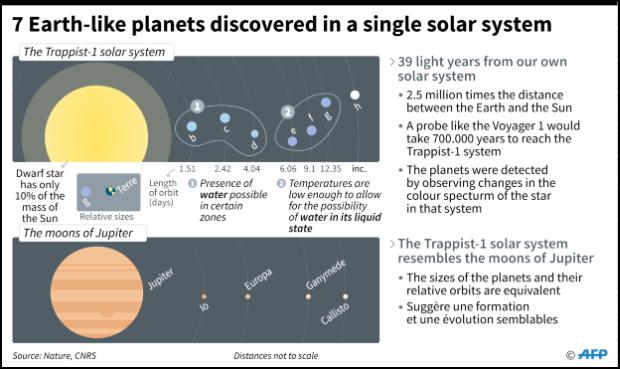Seven Earth-like planets discovered around single star

The Trappist-1 solar system, which has several Earth-like planets that could have life-nurturing water. (AFP graphics by SIMON MALFATTO, SABRINA BLANCHARD, JONATHAN JACOBSEN)
Paris, France — Researchers announced Wednesday the stunning discovery of seven Earth-like planets orbiting a small star in our galaxy, opening up the most promising hunting ground so far for life beyond the Solar System.
All seven roughly match the size and mass of our own planet and are almost certainly rocky, and three are perfectly perched to harbor life-nurturing oceans of water, they reported in the journal Nature.
Most critically, their proximity to Earth and the dimness of their red dwarf star, called Trappist-1, will allow astronomers to parse each one’s atmosphere in search of chemical signatures of biological activity.
“We have made a crucial step towards finding life out there,” said co-author Amaury Triaud, a scientist at the University of Cambridge.
“Up to now, I don’t think we have had the right planets to find out,” he said in a news briefing.
“Now we have the right target.”
The Trappist-1 system, a mere 39 light years distant, has the largest number of Earth-sized planets known to orbit a single star.
It also has the most within the so-called “temperate zone” – not so hot that water evaporates, nor so cold that it freezes rock-solid.
The discovery adds to growing evidence that our home galaxy, the Milky Way, may be populated with tens of billions of worlds not unlike our own – far more than previously suspected.
Remarkably, professional stargazers may simply have been looking in the wrong place.
“The great idea of this approach was to study planets around the smallest stars of the galaxy, and close to us,” said lead author Michael Gillon, a professor at the University of Liege in Belgium.
‘Ultracool’ dwarf star
“That is something nobody did before us – most astronomers were focused on stars like our Sun,” he told journalists ahead of publication.
Gillon and his team began to track Trappist-1 – a so-called “ultracool” dwarf star with less than 10 percent the mass of the Sun – with a dedicated telescope in 2010, and reported last year on three planets in its orbit.
They detected the invisible exoplanets using the so-called “transit” method: when an orbiting world passes between a star and an astronomer peering through a telescope, it dims the starlight by a tiny but measurable amount.
But when subsequent calculations didn’t quite tally, Gillon realized that there might be other stars that had escaped Earth-bound observation.
“So we requested time with NASA’s Spitzer Space Telescope,” said co-author Emmanuel Jehin, also at the University of Liege.
“This allowed us to get 20 consecutive 24-hour periods of observation, which was crucial to discovering that we had seven transiting planets.”
Looking from Earth, the astronomers could only track activity around the star at night.
“From space, we observed continually and matched all the transits,” 34 in all.
Compared to the distance between our Sun and its planets, the Trappist-1 family is very tightly bunched.
Indeed, the dwarf star and its seven satellites – with orbits ranging from 1.5 to 12 days – would all fit comfortably in the distance between the Sun and its closest planet, Mercury.
Like a sunset
If Earth were that close to the Sun, it would be a hellish ball of fire.
But because Trappist-1 emits far less radiation, temperatures on its planets – depending on the atmosphere – could be between zero and 100 degrees Celsius (32 and 212 degrees Fahrenheit), the scientists said.
Gillon and his team have started to analyze the chemical make-up of the atmospheres.
“There is at least one combination of molecules, if present with relative abundance, that would tell us there is life, with 99 percent confidence,” said Gillon.
A certain mix of methane, oxygen or ozone, and carbon dioxide, for example, could almost certainly come only from biological sources.
“But except for detecting a message from beyond our solar system from intelligence out there, we will never be 100 percent sure,” he added.
Someone standing on, say, Trappist-1 D, E or F – the three middle planets – would have a breathtaking panorama of the star and its system, Triaud said.
The red dwarf – which would loom 10 times larger than the Sun in our sky – would be a “deep crimson” shading into a salmon-like color, he said.
“The view would be beautiful – you would have about 200 times less light that from the Sun on Earth at midday,” he added.
“It would be like the end of a sunset.” –Marlowe Hood














